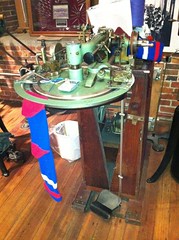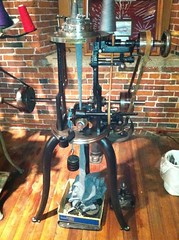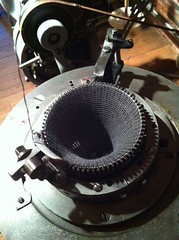 Last Friday the trouble makers in my Library Knitting group informed me that Patternworks was having it's annual tent sale over the weekend.
Last Friday the trouble makers in my Library Knitting group informed me that Patternworks was having it's annual tent sale over the weekend.Of course I didn't need new yarn or new books, but when has that ever stopped us before? Another thing not stopping me was that Hubby was out of town (he's home now) so I was running loose.
I managed to avert my eyes from the yarn and waltz out with just "Getting Started Knitting Socks" by Ann Bud and "Sock Innovation" by Cookie A. Both on sale, wheee! They did not have either the Neatby finishing book or the Lavold books I've been seeking. Might have to break down and have someone do a special order for me.
Socks! Socks in a Museum!
After finishing at the store I headed over to the Historic Belknap Mill to take a look at their sock knitting machines.
I'd found out about this place a few months ago. One day Hubby came home from school and said he was bored and we should go exploring. I checked out the Visit NH website for nearby day-trip type activities, but by the time I'd settled on the Mill Hubby had fallen asleep. So perhaps he wasn't bored as much as he was tired.
Not that I think he would have found sock knitting machines as fascinating as I do, but he's a good sport. (Well, we both are, really.)
Anyway.
The sock knitting machines were so cool, even if I didn't get to see them in action.
The museum doesn't really have Saturday hours, but they were open because there was a
 wedding reception on the third floor. The downside was I could only explore the first floor because there was a wedding reception on the third floor.
wedding reception on the third floor. The downside was I could only explore the first floor because there was a wedding reception on the third floor.Historical and Stuff
The first floor was the gift shop and one big room with a bunch of knitting machines.
Apparently the area was a hot bed of not only sock knitting but sock knitting machine building back in the day.
I found a script they use when school groups are in and it gave instructions when to turn on the machines. I could also tell some of the machines were functional because they had in-process socks on them. But the real clue was that the mill sells socks knit on premises in the gift shop.
The were plaques on the walls explaining the knitting process and how different machines made different parts of the socks. Of course, different people were trained on each step and there were even little kids who had to turn the socks inside out for one part and then back right-side out for the next.

As is often the case, the plaques said the first machine operators were men and then women slowly took over. But while the operators switched over to women, the machine fixers continued to just be men. Of course my modern sensibilities were annoyed by this.
It's not like these people where going to school and college for this; it was all on the job training. Did no women express interest in being fixers? Where they laughed at because women were too delicate or not smart enough?
It made me feel fortunate that we live in a time (and country) were (most) people realize that although there may be biological differences in the way men's and women's brains work we can equally rise to the challenges placed before us. And that with proper training I can complete a task even though I'm a woman.
Oh, another thing that gave me a turn was realizing some of the people quoted in the plaques might still be alive. Or were until very recently. The place was built in the 1800s but operational until the 1960.
In addition to the machines that knit socks there was a machine that knit I-cord! At first I wondered why they would want all that I-cord then turned around to a table of toe-less socks and saw shoelaces.
The socks were of a very fine weight and fabric. The yarn coming off the cones looked lace weight and you wouldn't catch me hand-knitting socks with yarn that thin. Driving over I'd wondered if there was a machine that did the ribbing for the cuff. Turns out they did a reverse stockinette cuff. That was one of the jobs, switching the sock from one machine to the other to make the cuff.
It made an attractive cuff for the socks at the Mill, but I think I'll stick with ribbing on the socks I knit.

Souvenirs
Part of me had been secretly hoping they'd have functioning, tabletop replicas of the machines for sale.
Boy howdy, could I blast through my sock yarn stash if I had a sock knitting machine! I could crank out the legs then do the feet by hand. I might have to knitting the ribbing by hand first, but that would have been fine.
All those day dreams were just that, though, since they didn't have machines for sale.
They did, however, have an original hand cranked machine for the home knitter. It was as big as any of the electric machines. It was not for sale, but there wouldn't have been room for it in our apartment anyway. And I think my sock yarn stash would have been too thick.
The museum doesn't have an admission price. It is supported by donations and sales in the gift shop. As I mentioned, they sold socks knit on-site in the gift shop. They also sold the shoelaces and loops of knit fabric like kids use to make those loom woven potholders.
They were very nice socks and decently priced, but I was pretty sure they'd be too big for me. Instead I bought a pair of the "Darn Tough" hiking socks, which are made in Vermont. They will come in handy if Hubby and I follow through on our declarations of doing more outdoor activities now that we're back in NH.
I also bought a cute little wooden ruler.
Knitters Everywhere
I would be remiss if I did not mention that half the fun of the museum was that the staff member on duty (another Ann) was also a knitter!
We had a grand time talking about knitting in general and knitting socks in particular. I confirmed things she'd been told about how wonderful Ravlery is and we found each other on Twitter.
All in all, it was a fun and educational afternoon.

No comments:
Post a Comment